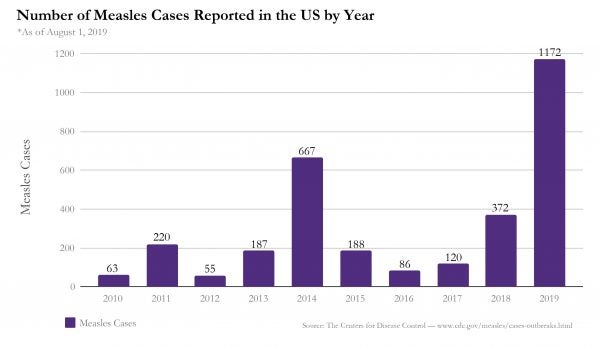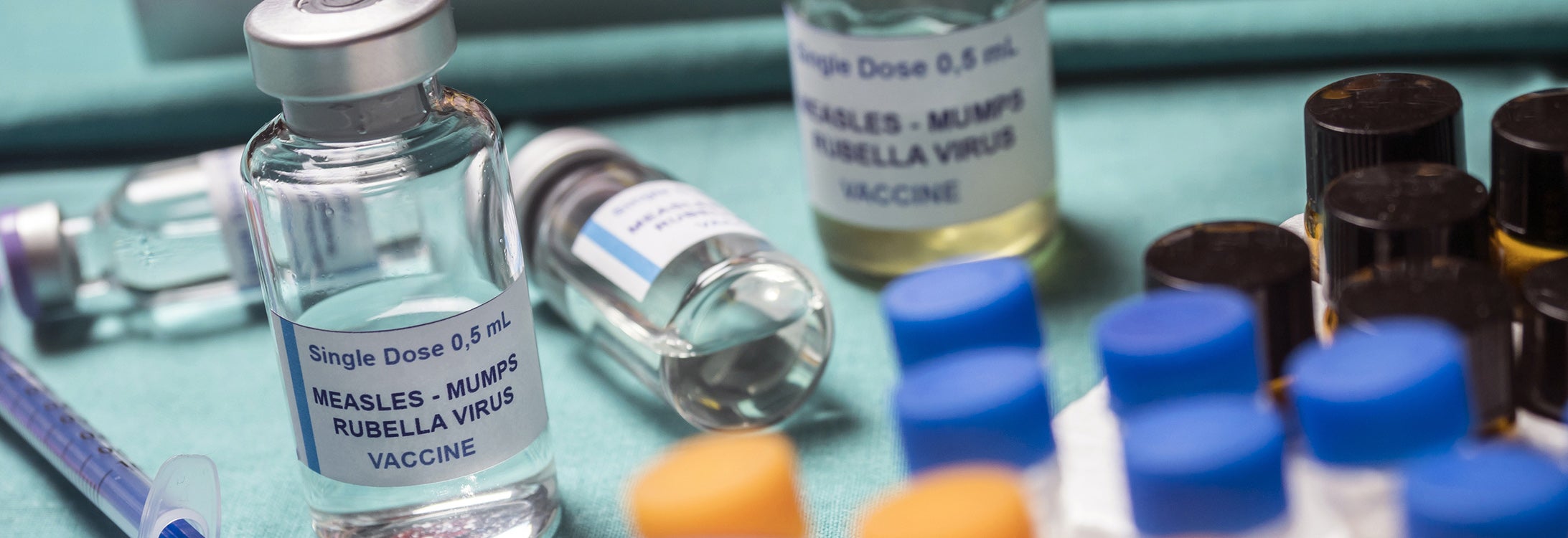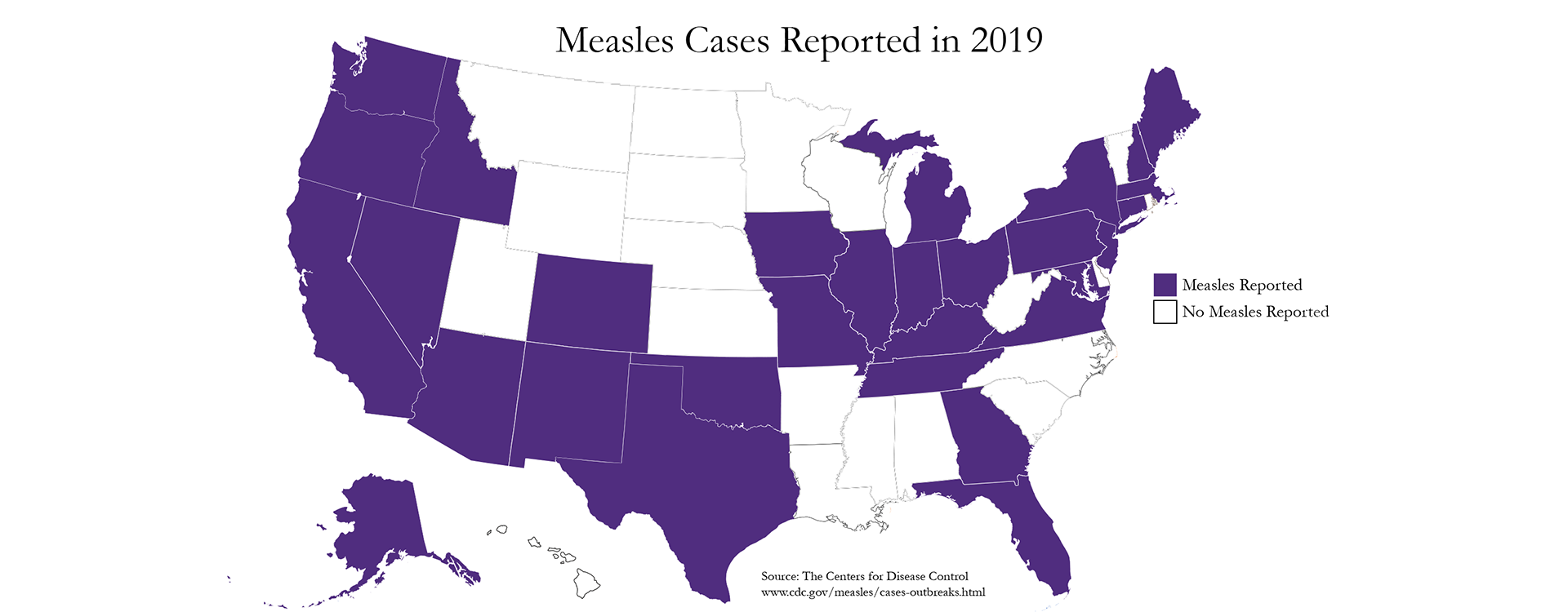SUSPICIOUS SPOTS?
8 things to know about the measles
A disease that many thought we had eradicated — at least in our part of the world — is making a comeback in parts of the United States and abroad. According to the Centers for Disease Control and Prevention, in the decade before 1963 when a vaccine became available, nearly all children got measles by the time they were 15 years old.
But since the vaccine was developed and was refined to the current version, widespread vaccinations have drastically reduced disease rates and measles was declared eliminated from the United States in 2000. However, the spread of misinformation about side effects incorrectly attributed to the vaccine has resulted in a resurgence of measles cases.
We talked to Dr. Paul Cook, chief of the Division of Infectious Diseases at ECU’s Brody School of Medicine, to help set the record straight and to learn what people in our area need to know.
- The measles vaccine is administered in two doses and is usually given to children by their primary care provider.
The vaccine commonly provided in the US protects against three diseases — measles, mumps and rubella, and is known as the MMR vaccine.
 The measles vaccine does not cause autism. This myth was started by a now widely discredited research paper published in 1997 in the medical journal The Lancet, suggesting that the MMR vaccine was increasing autism in British children. That study was retracted by the publication in 1998, and the physician who authored the paper lost his license to practice medicine after evidence emerged that he deliberately falsified the research cited in the paper.
The measles vaccine does not cause autism. This myth was started by a now widely discredited research paper published in 1997 in the medical journal The Lancet, suggesting that the MMR vaccine was increasing autism in British children. That study was retracted by the publication in 1998, and the physician who authored the paper lost his license to practice medicine after evidence emerged that he deliberately falsified the research cited in the paper.
“This doctor lost his license and no longer practices in Britain, but he did more to discredit this vaccine than any single individual has ever done,” Cook said. “This article that he published back in the ’90s has been retracted — and you don’t see many retractions of articles. That’s how serious this publication was and how misleading it was. But it has misled a lot of people to avoid getting the vaccine that is extremely safe and extremely effective.”
- Everyone over the age of 15 months needs to be vaccinated for the measles — unless you were born before 1957.
“Everybody needs to get the vaccine, and for the most part, everybody does get the vaccine. There are exceptions and that’s where the problem lies,” Cook said. “Primary care physicians usually give these at 15 months. The reason it’s not given at birth is that there’s a transfer of protective antibodies from the mother to the child at birth, and because of those antibodies, you wouldn’t get a response to the vaccine if you gave it at birth. The only reason the vaccine would not be given at 15 months is if the mother said, ‘I don’t want to give that vaccine,’ but physicians are very good at convincing mothers that the child needs the vaccine. So, our vaccination rate is very high.”
- Those born before 1957 are considered immune for life against measles.
“There was no vaccine before 1957,” Cook said. “Measles is one of the most infectious viruses on the face of the earth. Because of that, if you were born before 1957, it’s assumed that you had measles — you might not remember it, but you had it.”
- If you’re not sure whether you’ve had two doses of the vaccine (yes, you need two), there’s no harm in getting another to be safe — especially if you’re headed to an area not labeled measles-free. The Centers for Disease Control (CDC) provides a tool that can help travelers determine whether they need a vaccination before departure.
“If there’s any concern about whether you’ve had the second dose, we just say ‘just give it.’ It’s a very safe vaccine. It’s a very effective vaccine. The side effects from it are minimal and it’s relatively cheap,” Cook said.
- The ‘Three Cs’ are often the first symptoms of measles.
Most of today’s physicians have never seen a case of the measles in person, so there is some concern that it could be misdiagnosed. Before the telltale red bumps begin appearing on an infected person’s body, physicians at the Brody School of Medicine are taught to look for the ‘Three Cs’ — Conjunctivitis (redness, itching and/or tearing in the eyes), Coryza (a runny nose), and Cough.
“If you see (measles) in a child, the rash usually starts in the face, and if they have the red eyes, the droopy eyes and the runny nose, that’s the measles,” Cook said. “Usually (the rash) starts in the face and moves to the trunk. Before they get the rash, they can get these things called Koplik’s spots and they’re in the mouth and they look like sandpaper.”
- The measles is not life-threatening in and of itself, and it goes away on its own — but it is extremely contagious and complications from it can be deadly.
“The measles disease for the most part, in children, is a relatively benign illness, but it has the potential to cause very serious complications. Some of them are life-threatening: hearing loss, pneumonitis or pneumonia, there’s a brain disease that’s very rare — subacute sclerosing panencephalitis (SSPE) — if you get it, you’re basically messed up for life.”
- There have been no confirmed cases of the measles in North Carolina recently, but the disease is seeing a resurgence in other parts of the country and abroad. Just this year, 1,172 cases of the measles had been confirmed in 30 states as of Aug. 1. This is the greatest number of cases reported in the country since 1992 and since measles was declared eliminated in 2000. Cases have been reported in states bordering North Carolina, including Virginia, Tennessee and Georgia. States with ongoing outbreaks (defined as three or more cases by the CDC) are California, New York, Texas and Washington.



